Saipan and the B-29
By Dorothy Sprague
The Commonwealth of the Northern Mariana Islands lies in the Western Pacific and includes Saipan and Tinian. Saipan, the second largest island in the Northern Mariana Islands archipelago, was viewed by the Japanese as one of their last lines of defense protecting the homeland. Due to this proximity, the Imperial Japanese Army and Imperial Japanese Navy built extensive fortifications on the island and were strongly committed to defending it. On June 15, 1944, the United States Marines and the United States Army began an assault on Saipan.
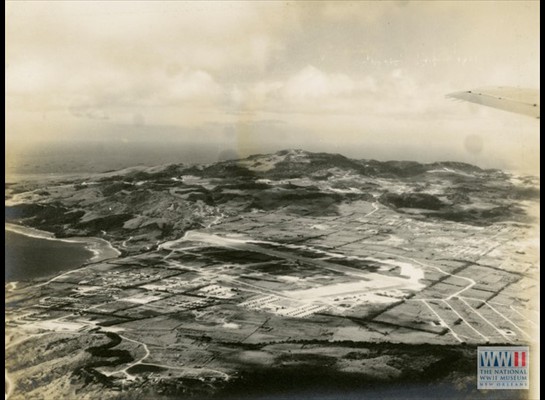 Saipan 1945 (photo courtesy of National WWII Museum).
Saipan 1945 (photo courtesy of National WWII Museum).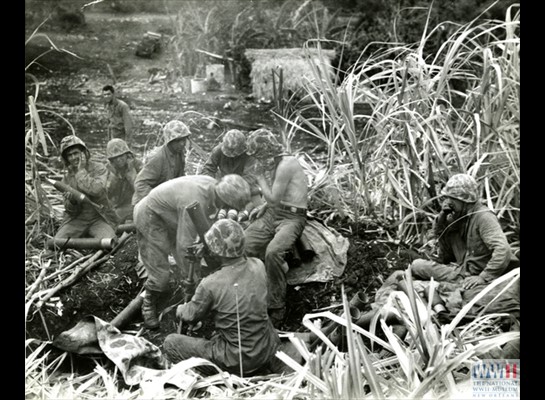 Marine mortar crew lobs shells at Japanese positions in June 1944 (photo courtesy of National WWII Museum).
Marine mortar crew lobs shells at Japanese positions in June 1944 (photo courtesy of National WWII Museum).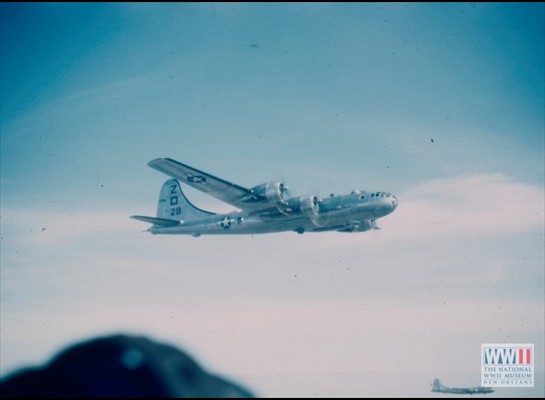 B-29 out of Isley Field in 1945 (photo courtesy of National WWII Museum).
B-29 out of Isley Field in 1945 (photo courtesy of National WWII Museum). Aerial view of Tinian, with North Field in foreground (photo courtesy of National WWII Museum).
Aerial view of Tinian, with North Field in foreground (photo courtesy of National WWII Museum).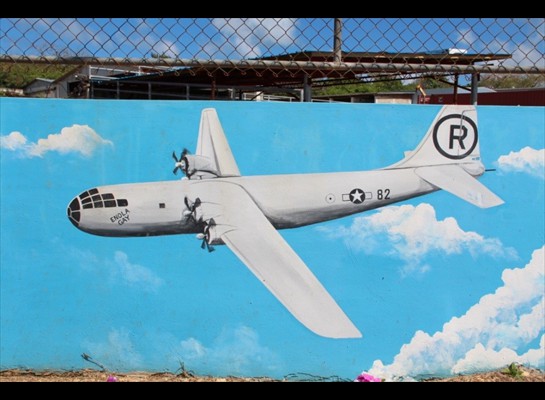 Mural of the Enola Gay at the intersection of As Perdida Road and Chalan Msgr Martinez (photo by D. Sprague).
Mural of the Enola Gay at the intersection of As Perdida Road and Chalan Msgr Martinez (photo by D. Sprague).
This unassuming island became the location of one of the major campaigns of World War II. Between June 15 and July 9, the United States armed forces fought the Japanese through the dense jungle to secure the island. As they were forced to retreat to the North, the Imperial Japanese Army regrouped at a site now known as the "Last Command" to launch a final attack, despite being out numbered and out-gunned. The United States military was able to push the Japanese all the way to Marpi Point at the northermost tip of the island where many Japanese soldiers and civilians chose or were forced to jump off of the high cliffs to their deaths, rather than face being imprisoned by or surrender to the United States.
After the Battle of Saipan, the United States set up airfields and brought in the B-29 Superfortress, using Saipan and its neighboring island, Tinian, as a base for bombing raids on the Japanese homeland.
The Boeing B-29 Superfortress was a strategic long-range, high-altitude heavy bomber aircraft introduced in 1943. At the time of its debut, the B-29 was described as the "perfect" bomber. At 9m in height, the aircraft ran 30.18m long with a 43.6m wingspan; it weighed 32,369kg empty with a maximum takeoff weight of 64,000kg. The B-29 could reach a maximum speed of 576kmh, travelling with a maximum tested range of 6,598km. Its standard armament included 12 electrically-operated 12.7mm Browning M2 machine guns and a 20mm M2 cannon on its tail; in addition, the Superfortress could carry up to 20,000lbs of additional internal ordinance, re-writing the capabilities of air warfare.
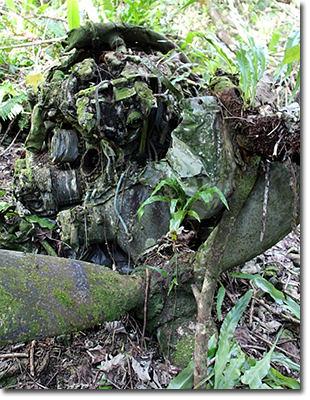
B-29 crash site located on Mount Tapochau (photo by D. Sprague).
The powerful new weapon took its first flight on September 21, 1942 which lasted a mere 35 minutes at the Boeing factory in Wichita, Kansas. When the Superfortress was first introduced to the U.S. public, it was touted as one of the most rigorously tested aircraft in history, with the supercharger for the engines alone undergoing over 5,000 hours of testing. The B-29 was equipped with 18-cylinder radial engines for which no single supercharger had sufficient capacity to supply; therefore, it was converted to a twin installation, requiring the development of the first dual nose wheel for its tricycle landing gear to support the incredible weight. This plane would end World War II, and usher in the age of nuclear warfare.
Dorothy Sprague, a graduate student at East Carolina University, is conducting field-based research for a thesis that focuses on the B-29 and its role in the Pacific Theater during World War II. Dorothy is visiting sites on both Saipan and Tinian that pertain to the operations of this historic aircraft. On Saipan, she has visited Aslito (formerly known as Isley) Airfield, the first stop for the B-29 on its way to Tinian during the war. At Aslito, Dorothy has examined the remains of the power plant, a bomb storage facility, and the railroad tracks that formed the backbone of Japanese military logistics. She has also visited extant bunkers, air raid shelters and pillboxes that the Japanese army used during the Battle of Saipan.
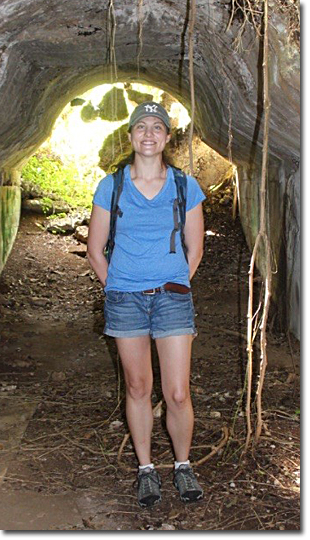
Dorothy Sprague at a Japanese emplacement at the northern end of Saipan (photo by J. McKinnon).
Dorothy is in the process of documenting a B-29 crash site located on Mount Tapochau, studying the crash site and the scattered assemblage of airplane parts with the goal of a site plan. On Friday, Dorothy ventured to Tinian where she visited the North Airfield, the main site of B-29 activity, and the location of the Atomic Bomb bays; the hydraulic lifts that loaded these massive bombs into the modified "Silverplate" B-29 were specially modified for the purpose of delivering the atomic bombs.
Using this information about the B-29 and relevant sites that supported it, Dorothy will generate an "airscape" in GIS. The concept of an "airscape" is borrowed from the theoretical construct pioneered by Christer Westerdahl, called a "maritime cultural landscape". This framework for viewing the land from sea will be applied to the air, effectively creating an airscape that is tailored to the B-29.
It is from airfields on Saipan and Tinian that the Enola Gay would take off and drop the atomic bomb called "Little Boy" on Hiroshima; and three days later, Bockscar would drop the second atomic bomb called "Fat Man" on Nagasaki, ending the hostilities of World War II and changing the political landscape forever.
Previous Next

